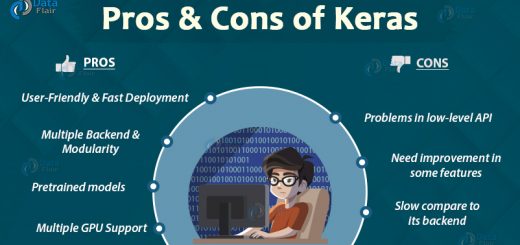What is Keras?
DEFINITION
Machine Learning (ML), Deep Learning (DL) has gained popularity in recent years. Thanks to the significant growth of DL/ML in almost fields of our lives, many libraries have been released to support modeling ML/DL. This helps developers as well as AI researchers to build a model quickly and easily. Among a wide variety of programming languages today, Python is considered as the most popular and friendly language in ML since its syntax is clearly brief and easy to understand. There are some current libraries that allow us to simplify the process of building DL models. Some famous libraries for DL are TensorFlow, CNTK, Theano, or Caffee. Among these libraries, TensorFlow developed by Google is the most used library by the community. However, TensorFlow is a relatively difficult framework to use, some newbies coming to DL will encounter many difficulties when reaching to this framework. This is the reason why they would like to use Keras – the DL framework that is not only user-friendly but also very powerful.
Keras is a deep learning API written in Python, running on top of the machine learning platform TensorFlow. It was developed with a focus on enabling fast experimentation. Being able to go from idea to result as fast as possible is key to doing good research.
Keras is an API designed for human beings, not machines. Keras follows best practices for reducing cognitive load: it offers consistent & simple APIs, it minimizes the number of user actions required for common use cases, and it provides clear & actionable error messages. It also has extensive documentation and developer guides.
This makes Keras easy to learn and easy to use. As a Keras user, you are more productive, allowing you to try more ideas than your competition, faster — which in turn helps you win machine learning competitions.
This ease of use does not come at the cost of reduced flexibility: because Keras integrates deeply with low-level TensorFlow functionality, it enables you to develop highly hackable workflows where any piece of functionality can be customized.
ADVANTAGES
User-Friendly and Fast Deployment
Keras is a user-friendly API and it is very easy to create neural network models with Keras. It is good for implementing deep learning algorithms and natural language processing. We can build a neural network model in just a few lines of code.
You can see, it is easy to understand the process and the flow. The functions and the parameters are very simple and therefore writing the code is simple. There is a good collection of Keras functions to do data processing. Keras provides multiple layers including the support for Convolution and Recurrent Layers.
Quality Documentation and Large Community Support
Keras has one of the best documentations ever. Documentation introduces you to each function in a very organized and sequential way. The codes and the examples given are very useful to understand the behavior of the method.
Keras also has great community support. There are lots of community codes on various open-source platforms. Many developers and Data Science enthusiasts prefer Keras for competing in Data Science challenges. So, we have a constant stream of insightful competition codes in Keras. Many of the researchers publish their codes and tutorials to the general public.
Multiple Backend and Modularity
Keras provides multiple backend support, where Tensorflow, Theano and CNTK being the most common backends. We can choose any of these backends according to the needs of different projects.
We can also train the Keras model on one backend and test its results on others. It is very easy to change a backend in Keras, you just have to write the name of the backend in the configuration file.
Pretrained models
Keras provides some deep learning models with their pre-trained weights. We can use these models directly for making predictions or feature extraction.
These models have built-in weights, these weights are the results of training the model on ImageNet dataset.
Some of the available models are:
- Xception
- VGG16
- VGG19
- ResNet, ResNetV2
- InceptionV3
- InceptionResNetV2
- MobileNet
- MobileNetV2
- DenseNet
- NASNet
Multiple GPU Support
Keras allows us to train our model on a single GPU or use multiple GPUs. It provides built-in support for data parallelism. It can process a very large amount of data.
DISADVANTAGES
Problems in low-level API
Sometimes you get low-level backend errors continuously and it becomes very irritating. These errors occur because we may want to perform some operations that Keras was not designed for.
It does not allow to modify much about its backend. Error logs are difficult to debug.
Need improvement in some features
Keras data-preprocessing tools are not that much satisfying when we compare it with other packages like scikit-learn. It is not so good to build some basic machine learning algorithms like clustering and PCM (principal component analysis). It does not have features of dynamic chart creation.
Slower than its backend
Sometimes it is slow on GPU and takes longer time in computation compared with its backends. So we may have to sacrifice speed for its user-friendliness.
iRender is currently providing GPU Cloud for AI/DL service that allows users working in the technology field to make use of our high configuration and performance machines for their purpose of training models. We support all Deep Learning Frameworks in the world, of course, Keras is a must. Just a few clicks, you are able to get access to our machine and take full control of it. Your model training has never been that fast as it can be 10 times or even 50 times faster.
To learn more, please contact us or sign up here and try using our services!
Source: keras.io



